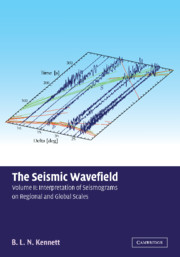Book contents
- Frontmatter
- Contents
- Preface to Volume II
- Part III Local and Regional Events
- Part IV Global Wave Propagation
- Part V The Three-dimensional Earth
- 30 The Influence of Heterogeneity
- 31 Imaging the Earth
- 32 3-D Global Structure
- 33 Mapping the Lithosphere and Upper Mantle
- Appendix Paths and Travel times
- Bibliography
- Index
30 - The Influence of Heterogeneity
from Part V - The Three-dimensional Earth
Published online by Cambridge University Press: 31 August 2019
- Frontmatter
- Contents
- Preface to Volume II
- Part III Local and Regional Events
- Part IV Global Wave Propagation
- Part V The Three-dimensional Earth
- 30 The Influence of Heterogeneity
- 31 Imaging the Earth
- 32 3-D Global Structure
- 33 Mapping the Lithosphere and Upper Mantle
- Appendix Paths and Travel times
- Bibliography
- Index
Summary
Only the simplest seismic wave propagation problems are amenable to a direct analytic solution. As we have seen in Part II, for stratified media the methods of attack have been based on a semi-analytic approach in which transform methods are used to simplify the equations so that attention can be concentrated on behaviour in the frequency-slowness domain; the resulting integrals need to be evaluated numerically. Once we face a three-dimensionally varying medium the simplicity of such transform methods are lost, and coupling between different slowness components has to be taken into account to describe the passage of waves through the 3-D structure (see, e.g., Haines, 1988). This approach can be quite successful for some classes of simple problems where the the medium remains quasi-stratified but the shape of interfaces are distorted (Koketsu et al., 1991). Interaction of the seismic wavefield with isolated heterogeneities can also be tackled by using specific developments based on a multipole representation of the resulting scattered wavefield as in the T-matrix methods of Boström & Karlsson (1984) and Bostock & Kennett (1992). However, multiple interactions between ‘scatterers’ or between the scattered field and interfaces rapidly leads to challenging computational issues.
For fully three-dimensional problems a more direct attack is needed. At high frequencies the main tool is asymptotic ray theory, as introduced in Chapter I:9. These techniques have been progressively developed to allow for full 3-dimensional variations including the influence of anisotropic structures. Červený (2001) provides a comprehensive development of the current state of the theory for local and regional scale problems. The results for global models for both body waves and surface waves are presented by Dahlen & Tromp (1998, Chapters 15, 16). The details of the implementation of ray methods are quite dependent on the way in which the three-dimensional structure is described, and in particular on the specification of interfaces and their interaction.
Ray methods provide travel times and, with extra effort, amplitude information in a high frequency approximation. They are therefore a fundamental tool in understanding the nature of the main propagation processes, in the same way as we have used them for stratified structures.
- Type
- Chapter
- Information
- The Seismic WavefieldVolume II: Interpretation of Seismograms on Regional and Global Scales, pp. 401 - 425Publisher: Cambridge University PressPrint publication year: 2002



